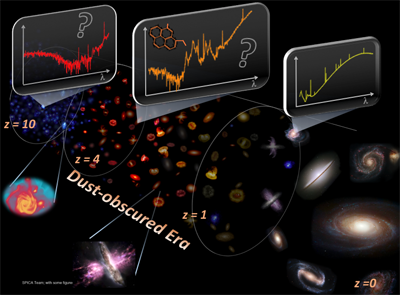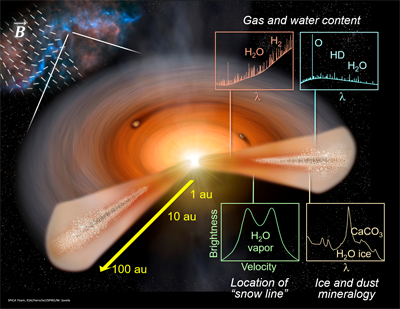Science
-
-

Metal and dust enrichment through galaxy formation
The Universe was simple just after the Big Bang of 13.8 billion years ago, composed of mainly hydrogen and helium. However, the current Universe is full of various matters such as metal-rich gasses and dust grains. In order to understand the metal and dust enrichment in the Universe, it is necessary to explore how the stars and galaxies are born and evolve in the comic history. However, the dust formed through the evolution of stars extinguishes the light, resulting in masking any inside-activities. Therefore, the cosmic history when the metal and dust were most produced is still a mystery. SMI will observe spectral lines from atoms, molecules, and ions as well as various dust emission features at mid-infrared wavelengths where dust extinction is small; SMI will search for and make spectral analyses of dust-obscured galaxies and active galactic nuclei, it will search for dust in the early Universe, and it will conduct spectral imaging of nearby galaxies.
-

Star / planetary formation to habitable systems
When and how the planets are formed such as Earth where our lives exist? Planets are currently considered to have formed within protoplanetary disks where dust and icy particles are accumulated in its equatorial plane to form planetesimals, and then grown to planets. However, it has not yet been fully understood when and where exactly they are formed. Water (both vapor and ice) is key species in the formation of habitable planets and their biological evolution. In addition, in order to understand the giant gas planet formation such as Jupiter, it is important to reveal when and how gases dissipate. SMI will observe the spatial distributions of molecular hydrogen, dust, and water that are best studied at mid-infrared wavelengths within the protoplanetary disks where planets are formed. These observations are expected to be linked to the understanding of the universality of the Solar System and Earth.
-
© 2018 BY ISAS/JAXA | ALL RIGHTS RESERVED